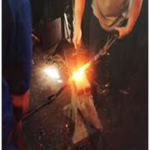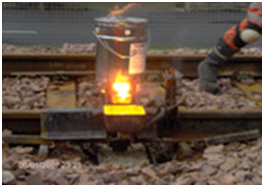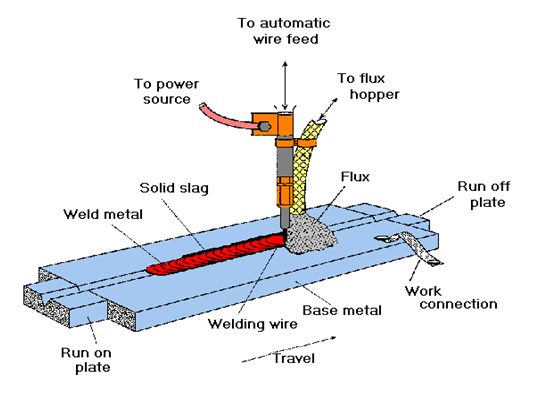Table of Contents
- Welding Metals – An Introduction
- Welding – A Definition
- Types of Welding by Metal
- Types of Welding by Method
- Fusion Welding (Electrical Energy)
- Solid-State and other Non-electric Fusion Welding
- Welding Processes
- Fusion welding
- Solid State welding
- DEFORMATION WELDING
- DIFFUSION WELDING
- Non-Fusion Process
- Introduction to Arc Welding
- Conclusion
Welding Metals – An Introduction
To join ferrous with non-ferrous metals, various methods can be adopted.
- Mechanical methods: Fasteners, rivets, etc.
- Adhesive bonding method: Brazing and Soldering (a.k.a. welding)
- Base metal does not fuse: Molten filler gets drawn into close-fit joints through capillary action (surface tension forces).
- Brazing filler melts at >450⁰C, soldering at <450⁰C
Welding is the most commonly used process of all.
Welding – A Definition
Welding can be described as a process of joining two or more pieces /edges of metal by producing a localized union through heat (fusion) with or without pressure to create a homogenous joint.
Types of Welding by Metal:
Autogenous: In this process, similar materials are joined without filler wire or electrode
Heterogeneous: Process of joining dissimilar materials, using a filler wire or welding electrode
Types of Welding by Method:
1. Fusion Welding (Electrical Energy):
- Manual Metal Arc welding / Flux Cored Arc welding / Shielded Metal Arc Welding
- TIG –Tungsten Inert Gas welding
- Metal Inert Gas welding or Metal Active Gas welding
- SAW – Submerged Arc Welding
2. Solid-State and other Non-electric Fusion Welding: Examples of non-fusion, non-electric process welding are:-
- Thermit welding
- Ultrasonic welding
- Diffusion welding
- Deformation welding.
Welding Processes
- Fusion welding: Welding in the liquid state with no pressure, Union is by molten metal bridging
- Solid State welding: Carried out below the melting point of the metal without filler additions, Pressure is often used,
Union is often by plastic flow.
Solid State welding:
DEFORMATION WELDING: Two Surfaces in contact are brought into very close contact by applying high pressure, which deforms them. E.g., – Forge welding, Roll welding, Extrusion welding. (Not at very high temperatures)
DIFFUSION WELDING: Joining takes place by atomic diffusion of 2 surfaces in contact. Surfaces are usually heated to high temperatures (below the melting point) & pressure may be employed. E.g., Brazing, Braze welding & Soldering. Soldering is an oxy-fuel process of joining metals. The process temperature does not exceed 450⁰. Brazing is also an Oxy-Fuel joining process. The process temperature is between 450⁰ Degrees – 750⁰ degrees. Braze welding is similar to Brazing; the process temperature is above 750⁰ Degrees but below the melting point of the base metal.
Non-Fusion Process: Thermit welding is the most common process used in joining of railway tracks. In this process iron powders and Al binders are kept in Vat or a conical container above the joining rails. When they are fired due to chemical reaction and exothermic reaction, the iron powder melts and forms a joint between rails.
Introduction to Arc Welding: Basic welding processes used in Industry are
- MMAW – Manual Metal Arc Welding or Shielded Metal Arc welding
- GMAW – Gas Metal Arc Welding/ Flux Cored Arc Welding (MIG, MAG)
- GTAW – Gas Tungsten Arc Welding (TIG)
- SAW – Submerged Arc Welding
MMAW or SMAW- Shielded Metal Arc process: In the Shielded Metal Arc process or Manual metal Arc welding process the arc is established between Parent Metal and a flux coated welding electrode using electrical energy to melt and deposit weld metal. This is the most commonly used process in the world.
Basic Requirements for the SMAW process:
Heat source: Welding Equipment Current Range 30-400 A –depending on size of the electrode in general, even though there are welding machines used up to 600 Amps AC or DC welding machines can be used in SMAW Operation.
Welding Consumable: Flux coated welding electrode (1.6- 8 mm diameter)
A trained welder is required to operate the process, So SMAW or MMAW is the most commonly used process in the world.
SMAW Process advantages:
- This is the simplest of all welding process.
- Equipment Portable
- Economical Cost of Equipment
- Variety of application & wide availability of electrodes
- Range of metals & their alloys can be welded
- Welding in all Positions
- Welding in Indoor & Outdoors
- Extended welding cable to long distances in comparison to another process
Limitations of SMAW process:
- Low productivity as in a 10-minute cycle welding happens only for 6 minutes
- Process also involves a frequent changes of welding electrode
- Moisture from flux coatings can create weld-related problems
- Safety problems like arc strike, Stray current & electric shock risks
- Absolutely Manual process – hence called Manual metal arc welding
GMAW & FCAW processes:
- A continuous solid wire, small diameter
GMAW uses solid wire, no flux
FCAW use flux-filled wire
- Wire feed through the gun to the arc by wire feeder.
- Weld pool may be protected from oxidation by shielding gas.
- High productivity 3 kg/h or more
- Direct current (DCEP mostly).
Process Requirement:
- Welding power source
- Wire feeder mechanism- In-built/separate
- Gun with gas supply & trigger switch
1. Manual/semi-automatic guns
2. Automatic torches available
3. Can be fitted to automation etc.
Advantages in GMAW:
- Faster as compared to TIG & SMAW.
- Can produce joints with deep penetration.
- Thick & thin, jobs can be welded effectively.
- Can be used for fabrication and maintenance repair job.
- Can be mechanized easily
- Reduced distortion.
Limitation in GMAW:
More Complex due to
- Electrode stick-out
- Torch angle
- Welding parameters
- Type and size of electrode
- Welding torch manipulation
- Not suitable for outdoor welding applications
GTAW or TIG welding: GTAW or Tungsten Inert gas welding uses a consumable Tungsten electrode as the heat source.
This consists of the below.
Heat source – welding power source to create an arc between a tungsten tip and the parent metal
30-400A, AC or DC welding machine and 0-20V
Inert gas shielding is used in the process.
Consumable: filler rod can be used between 1 to 4mm diameter
Process Features:
- Excellent control
1. Stable arc at low power (80A at 11V)
2. Independently added filler
3. Ideal for intricate welds eg root runs in the pipe or thin sheet
4. Low productivity 0.5kg/h manual - High quality
1. Clean process, no slag
2. Low oxygen and nitrogen weld metal
3. Defect-free, excellent profile even for single-sided welds
Advantages in GTAW/TIG Process:
- No slag inclusion
- Clear visibility of arc and job
- All position weldability
- Suitable for high quality welding of thin material
- Root run of thick materials
- Ideal for Aluminum, Stainless steel & Titanium
Limitations in GTAW:
- Slow as compared to SMAW/MIG/MAG & SAW welding
- Possibility of tungsten inclusion in the weld deposit which is hard & brittle
- Not suitable for outdoor welding
Submerged Arc welding process (SAW Process): In the Saw Process, as the name signifies, welding happens submerged beneath the flux. SAW process also employs welding consumables usually a wire & arc is established between the welding wire and base metal and welding happens underneath the metal powder of flux, shielding the arc from the atmosphere and its gases.
Heat source: Arc between a wire and base metal
Current Range: 200 Amps -1200 Amps
DC operation
Power Consumption
- 35-56 KVA
- Power source
- Welding head and control box
- Welding head travel
- Flux recovery system (optional)
- Positioners and Fixtures
Hence the basic difference between the two processes is that in the SMAW process, the flux-coated electrode provides the shielding from the atmosphere & in SAW process an external flux is delivered at the arcing area to act as a shield, so welding happens underneath the powder flux fed by a delivery system.
SMAW Process – Advantages:
- Simplest of all Arc welding process
- Equipment is portable
- Economical cost of equipment
- Variety of application & wide availability of electrodes
- Range of metals & their alloys can be welded
- Welding in all Positions
- Welding in Indoor & Outdoors
- Extended welding cable to long distances when compared to other processes
SAW Process advantages:
- High productivity up to 2 to 10 kg per hour
- Speed almost up to 2m/ min
- Can be easily automated for even higher productivity
Limitations of the SAW process:
- Bulky, expensive, and heavy equipment
- Flat and horizontal positions only
- Thicker sections (6mm and above)
- Mostly ferrous materials (also Ni alloys)
Conclusion: A wide variety of processes are available for joining or hard surfacing ferrous and non-ferrous materials. Each of these processes provides different mechanical properties and works in specific conditions, with a welding power source. There are several factors to consider in welding rod selection:
- Base metal properties
- Tensile strength required
- Welding current
- Base metal thickness, shape and joint fit-up
- Welding position
- Specification and service conditions
- No. of similar jobs – Scope for automation
- Environmental job conditions
These methods are all commonly used by Industry. Before we select any particular method for welding, we need to analyze each of the factors listed above.
ADFL serves the industry with the manufacture and supply of all types of consumables for MMAW, MIG /Mag, TIG, SAW & non-fusion processes like soldering, brazing, and braze welding. This is why Ador Fontech’s name is synonymous with total solutions for any maintenance & repair problem, ensuring the Life Enhancement of Industrial components, to the complete satisfaction of customers.
Reclaim, do not Replace




